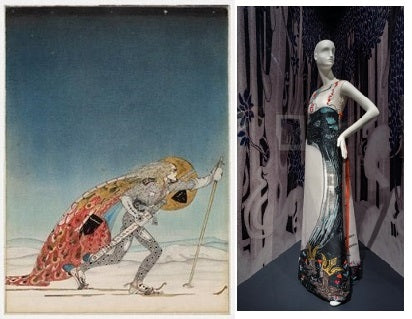More than a century ago, Danish illustrator Kay Nielsen (1886–1957) created  exquisite interpretations of classic fairy tales that remain some of the most memorable visions of enchantment and fantasy ever to appear in print. The MFA’s recent exhibition Kay Nielsen’s Enchanted Vision: The Kendra and Allan Daniel Collection, featured nearly 50 of his luminous and often haunting watercolors and drawings—including many of his remarkable illustrations for East of the Sun and West of the Moon, Old Tales from the North.
exquisite interpretations of classic fairy tales that remain some of the most memorable visions of enchantment and fantasy ever to appear in print. The MFA’s recent exhibition Kay Nielsen’s Enchanted Vision: The Kendra and Allan Daniel Collection, featured nearly 50 of his luminous and often haunting watercolors and drawings—including many of his remarkable illustrations for East of the Sun and West of the Moon, Old Tales from the North.
The son of a prominent theater director and actress, Nielsen was deeply immersed in the performing arts during his childhood in Copenhagen, a formative experience that influenced him throughout his life. He quickly gained international recognition as an artist and theater designer in his younger years, with original illustrations exhibited and sold to collectors in London and New York. During the final years of his career, he worked as an art director for Disney on the landmark animation film Fantasia and completed a handful of public art commissions. While his published output was relatively small, Nielsen is consistently cited as a luminary among European illustrators of the 20th century, and his work continues to inspire generations of artists across disciplines. "Then he coaxed her down and took her home," illustration to The Lassie and her Godmother, 1913–14, Transparent watercolor, pen and brush and ink, gesso and metallic paint over graphite (left)
"Then he coaxed her down and took her home," illustration to The Lassie and her Godmother, 1913–14, Transparent watercolor, pen and brush and ink, gesso and metallic paint over graphite (left)
Nielsen’s illustrations for a compilation of Norse tales, poetically titled East of the Sun and West of the Moon: Old Tales from the North, were published in 1914. Today they are considered the bedrock of his legacy as a leading European illustrator of the 20th century. Nielsen’s broad cultural and historical interests, as well as his “sense of the supernatural,” are reflected in his highly detailed and densely patterned illustrations, revealing his love of Norse mythology and his knowledge of Japanese woodblock prints and Persian miniatures.
Some of these tales are not well known today—the book might have faded into obscurity if not for Nielsen’s contribution. Filled with moments of high drama, his illustrations are much more than visual aids to propel the narration.
"So the man gave him a pair of snow-shoes," illustration to The Three Princesses of Whiteland, 1913–14, Transparent and opaque watercolor, pen and ink, metallic paint over graphite (right)
In 2015 the art book publisher Taschen released a new edition of East of the Sun and West of the Moon. When the book landed in the hands of celebrated fashion designer Karl Lagerfeld, Nielsen’s illustrations inspired him to create “Legends and Fairy Tales” for the Winter 2016 collection from the Italian couture fashion house Fendi. Lagerfeld and Fendi worked with two contemporary illustrators to translate Nielsen’s drawings from the Taschen book into three-dimensional garments and accessories.
Lagerfeld’s inspiration for this evening dress came from Nielsen’s illustration to The Three Princesses of Whiteland. It depicts a surreal moment when “the Lad” comes upon three princesses who have been pushed into the ground by trolls, so that only their heads are visible. Nielsen creates a dramatic composition with the arc of the stone cliff creating a void in the center of the image. Lagerfeld’s interpretation of Nielsen’s illustration, with the dripping fronds of the red willow used to ornament the shoulder of the garment, inserts the body of the wearer into the composition.
"They saw the cottage was made of bread and cakes," illustration to Hansel and Gretel, 1924, Transparent and opaque watercolor, pen and ink over graphite (left) Released a year after Fairy Tales by Hans Andersen, this Grimm Brothers publication creates a different experience for the reader, with bolder illustrations in a more saturated palette. Nielsen replaced the delicacy of the floral border elements and muted colors with stronger jewel tones and greater depth to the scenes. This difference in overall presentation may reflect the influence of his publisher Hodder & Stoughton. Contemporary marketing of illustrated books reveals that stories and illustrators were selected and release dates carefully timed with heightened awareness of the competition.
Released a year after Fairy Tales by Hans Andersen, this Grimm Brothers publication creates a different experience for the reader, with bolder illustrations in a more saturated palette. Nielsen replaced the delicacy of the floral border elements and muted colors with stronger jewel tones and greater depth to the scenes. This difference in overall presentation may reflect the influence of his publisher Hodder & Stoughton. Contemporary marketing of illustrated books reveals that stories and illustrators were selected and release dates carefully timed with heightened awareness of the competition.
Nielsen continued to experiment visually within the publication. Nielsen’s life-long immersion in the performing arts is reflected in many of his illustrations, which could readily be translated to the stage. They have a convincing sense of depth—this is especially evident in the illustration for Hansel and Gretel, with its ominous trees looming over the two children as they are drawn toward the gingerbread house. Nielsen’s use of a low viewpoint contributes to the impression of a theater set.
Text by Meghan Melvin, Sharf Curator of Design.
The MFA exhibition may be over, but you can still order a print of one of these enchanting illustrations.
